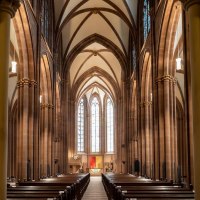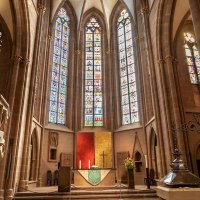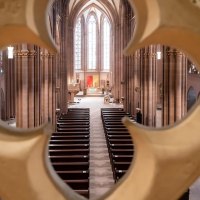The St. Catherine's Church is often referred to as the most significant Gothic church building on the Rhine between Strasbourg and Cologne. It catches the eye from afar, as it majestically towers over the center of Oppenheim. Only the two western towers remain from a large Romanesque predecessor building from the first decades of the 13th century. Around 1275, the construction of the Gothic new building began with the construction of the eastern choir. It progressed westward, from the transept with the crossing tower, through the nave to the base of the Romanesque towers. This construction phase was completed around 1340.
The final form of the church building was achieved a century later: the western choir was built, probably for the purposes of the St. Catherine's Foundation. The work began in 1415, and the consecration took place in 1439. About thirty years later, the two Romanesque towers were extended by a Gothic level to adapt to the new proportions. Over a construction period of more than two centuries, five very different components were created, which together still radiate a harmonious overall appearance.
A few years after the introduction of the Reformation in 1565, all altars, images, church furnishings, and parts of the windows fell victim to the Reformation iconoclasm. Even today, the empty pedestals along the columns along the central aisle are noticeable. In the Thirty Years' War, in 1621, the city was likely also affected by a major fire, which probably damaged St. Catherine's Church. During the Palatine War of Succession, in May 1689, large parts of the old windows were shattered when the Landskrone Castle was blown up. A few days later, the entire city was systematically burned down. The roofs collapsed first, followed by the vaults of St. Catherine's Church, and the interior was destroyed or damaged.
Only in the 19th century could the commitment and funds for comprehensive renovations be brought together. In May 1889, the church was grandly rededicated. Since then, St. Catherine's Church has presented itself in its current appearance.
After World War II, another extensive exterior and interior renovation took several decades.
St. Catherine's Church is famous primarily for its windows. The most significant ones are the two windows in the south facade: the Lily Window, which was reglazed in 1937, and the so-called Oppenheim Rose, whose glass panes from the 14th century (1332/1333) are largely original. The ground plan of the Oppenheim Rose was based on a wild rose, the symbol of God's love for humanity. The center of the window features the Imperial Eagle, the Oppenheim city coat of arms. Members of noble families residing in Oppenheim sought to be buried in St. Catherine's Church. Originally, there were over 100 tomb monuments in the church. Many of them were destroyed in the city's destruction in 1689. Among the surviving tomb monuments, those of spouses Johann von Dalberg and Anna von Bickenbach (d. 1415) and Anna von Dalberg (d. 1420) stand out.
On the north side of St. Catherine's Church, the two-story "Michael's Chapel," a mortuary chapel from before 1424, has been preserved. It houses an exhibition on the renovation history of St. Catherine's Church (visitation by request).
In the charnel house in the basement of Michael's Chapel, bones of approximately 20,000 citizens of Oppenheim from the years 1400 to 1750 are stacked. The remains of the deceased were, as customary in many places, transferred to the cellar vault of the mortuary chapel during reburials in the cramped cemetery. The Oppenheim charnel house is now considered the largest and best-preserved of its kind in Germany. Michael's Chapel with the charnel house can be viewed from the outside daily during the opening hours of the church.
Through the external staircase, you enter a garden designed like a cloister garden, featuring many biblical plants and ancient varieties of roses.










